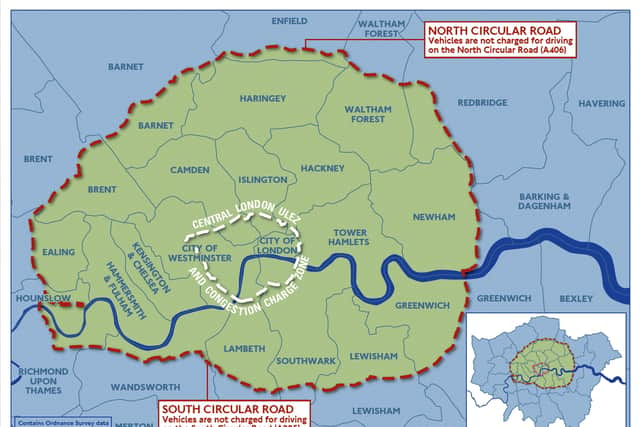London ULEZ charge: map of Ultra Low Emission Zone, how to check costs and pay as 2023 extension confirmed
and live on Freeview channel 276
London’s Ultra Low Emission Zone (ULEZ) - a scheme which sees polluting cars charged for driving in the city - is making headlines again after it proved to be a decisive issue in the Uxbridge by-election.
In a surprise result, the Conservative Party held Boris Johnson’s former seat in Uxbridge and South Ruislip - with Tory Councillor Steve Tuckwell beating Labour’s Danny Beales to be named as the constituency’s new MP. Speaking after the count, Tuckwell atrributed his success to the unpopularity of Sadiq Khan’s ULEZ, which is imminently due to expand into London’s outer boroughs, including Uxbridge.
Advertisement
Hide AdAdvertisement
Hide AdTuckwell said: “[Mayor] Sadiq Khan has lost Labour this election. It was his damaging and costly ULEZ policy that lost them this election. This wasn’t the campaign Labour expected and Keir Starmer and his mayor Sadiq Khan need to sit up and listen to the Uxbridge and South Ruislip residents.”
When it was first launched, the ULEZ covered the same central area as London’s Congestion Charge Zone - with drivers charged £12.50 a day to travel on these roads if their car is not compliant. Later, ULEZ was expanded to everywhere within the capital city’s North and South Circular roads, and in August, everyone who lives within the whole Greater London area will face the daily charges if their vehicle is considered too polluting.
Commenting on the changes coming in August, Khan said the move to expand the zone was “one of the toughest decisions I’ve taken” - but insisted that “public health comes before political expediency” as he argued the expansion would improve air quality for five million people. However, there are many critics of the scheme, with some arguing that, amidst a cost of living crisis, the “heavy handed” policy would be a “hammer blow” to hundreds of thousands of struggling families and businesses.
But what exactly is the ULEZ scheme, which areas will it cover, how much does it cost, and perhaps most importantly, does it affect you and your car? Here’s everything you need to know about areas, exemptions, daily charges, and how to check if your car is compliant.

What is the ULEZ?
Advertisement
Hide AdAdvertisement
Hide AdThe ULEZ is an area of London where vehicles that don’t meet certain emission standards are liable for a daily charge. The zone was created to improve air quality in the city by reducing the number of older, more polluting vehicles on the roads. The aim of expanding the zone this August is to cut nitrogen dioxide by around 30%.
Transport for London says the zone is designed to discourage drivers from using these vehicles and encourage them to use alternative forms of transport or switch to newer, cleaner vehicles.
Where does the ULEZ cover?
The ULEZ initially covered the same central area as London’s Congestion Charge zone but in October 2021 was expanded to cover all parts of the city within the North and South Circular roads.
It takes in all parts of the city from Haringey in the north and Southwark in the south to Newham in the east and Ealing in the west. It does not include the North and South Circulars themselves (A406 and A205, respectively).


Where will the ULEZ cover after the expansion?
Advertisement
Hide AdAdvertisement
Hide AdFrom August 2023 the ULEZ will be expanded beyond the North and South Circular roads to cover the whole Greater London area, encompassing most of the area within the M25, meaning around five million people in total will live within the ULEZ.
Transport for London (TfL) estimates that on an average day about 160,000 cars and 42,000 vans that use London’s roads would be liable for the ULEZ fee. Transport officials believe that by the end of next year the expansion of the scheme will have encouraged tens of thousands of drivers to switch to ULEZ-compliant vehicles or other forms of transport.


When does the ULEZ operate?
ULEZ charges apply 24 hours a day, seven days a week. Christmas Day is the only day the scheme is not in operation. The charge period runs from midnight to midnight, meaning that if you are in the zone before and after midnight on the same journey you will be charged for two days’ entry.
How much is the ULEZ charge?
The ULEZ charge for cars and motorbikes that don’t meet the minimum emissions standard is £12.50 per day. For lorries, coaches and other large vehicles, the charge is £100 per day.
How do I pay the ULEZ charge?
There are several ways to pay TfL for entering the ULEZ.
- Set up Auto Pay to automatically debit your account whenever you use the zone
- Pay online via the Transport for London website
- You can also use the official TfL Pay to Drive in London app. It is available from the Apple App Store or Google Play Store
- Pay by phone: UK: 0343 222 2222; International:+44 343 222 2222; Textphone: 020 7649 9123
What is the fine for failing to pay?
Advertisement
Hide AdAdvertisement
Hide AdFailing to pay the charge for a car or motorbike currently results in a fine of £160, reduced to £80 if paid within 14 days. For larger vehicles the fine is £1,000, reduced to £500. However, the fine for cars and motorbikes is set to increase to £180 in 2023.
What cars are exempt from ULEZ charges and how do I check if my car is compliant?
ULEZ compliance is worked out based on a vehicle’s emissions and TfL says that 80% of vehicles in the city are compliant, including all electric vehicles.
Petrol cars must meet Euro 4 emissions standards while diesel cars must be Euro 6 compliant. In general this means petrol cars registered after 2005 and diesel cars registered after September 2015 are exempt. Motorbikes must meet Euro 3 standards, which generally means anything registered after July 2003.


However, there are exceptions so the best way to find out if your vehicle is exempt is to use the TfL checker, which can be found on the Transport for London website. Classic cars older than 40 years old are exempt as long as they are registered as “historic” with the DVLA.
Advertisement
Hide AdAdvertisement
Hide AdDrivers can also apply for an exemption to charges if their vehicle is registered with a disabled or disabled passenger tax class. These exemptions will run until 24 October 2027. Blue Badge holders do not automatically qualify for exemption.
Patients travelling for NHS treatment and NHS staff may also qualify for a refund on any charge. Details on NHS reimbursements can be found on the TfL website.
Comment Guidelines
National World encourages reader discussion on our stories. User feedback, insights and back-and-forth exchanges add a rich layer of context to reporting. Please review our Community Guidelines before commenting.
